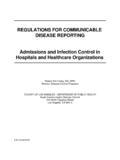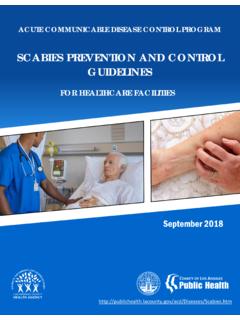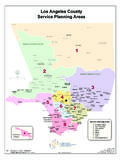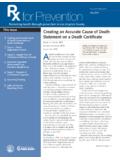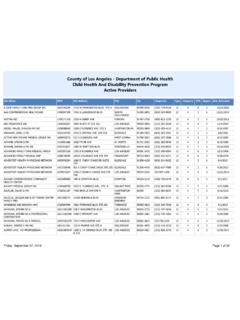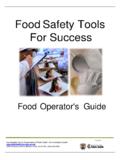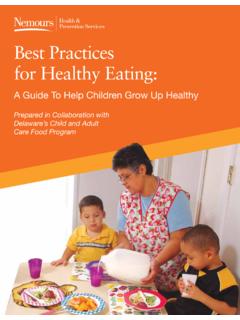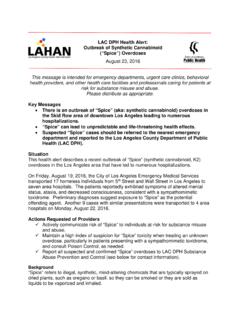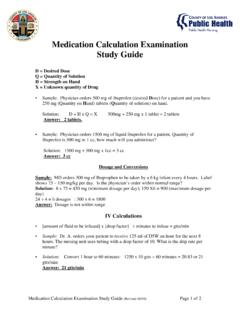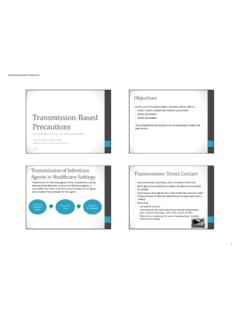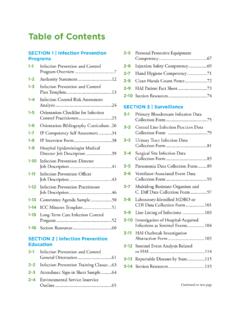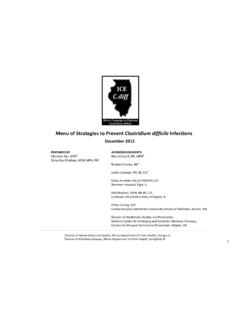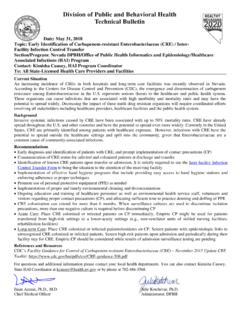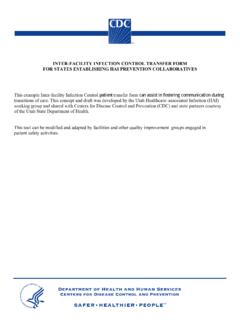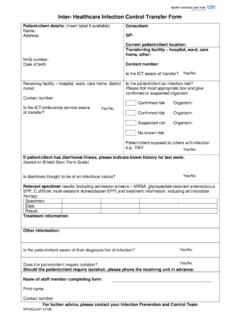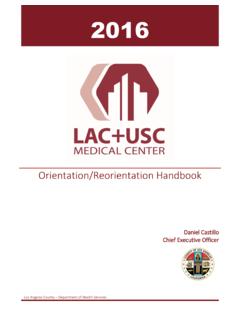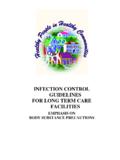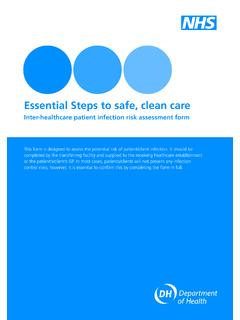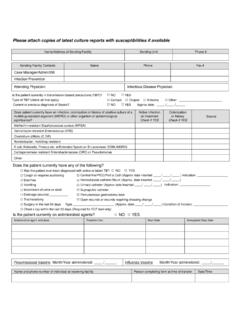Transcription of Infection Prevention and Control Assessment: Care Facilities
1 Infection Prevention and Control Assessment: Long term Care FacilitiesKaren Young Cho, RN, PHN, CICA cute Communicable Disease ControlLos Angeles County Department of Public HealthSeptember 28, the purpose of Infection Control assessment in skilled nursing Infection Control domains for gap most commonly identified gaps for each Background & Purposes CDC Infection Control assessment Response (ICAR) LAC IC assessment Process Overview of the CDC Infection Control assessment Most Commonly Identified Practices/Gaps duringLAC IC assessment Resources2 Infection Control assessment and Response (ICAR) Background: supported by funding from the Centers for Disease Control and Prevention (CDC) to perform on site ICAR.
2 LAC DPH ACDC Staff to perform on site ICAR in LA County in 2016: Acute Care Hospitals (ACHs) Skilled Nursing Facilities (SNFs) Ambulatory Surgery Centers (ASCs) Emergency Medical Services (EMS) Providers3 Infection Control assessment and Response (ICAR) (2)Purposes: To identify gaps in Infection Control policies and practices and provide feedback and resources. To better understand needs of SNFs broadly so ACDC can better develop programs and materials to meet those IC assessment Process Recruitment Process: Invitation email/letter sent out to some of the nursing home corporations and California Association of Health Facilities Purpose and Process of Visits 4 Components to the assessment Preparation Initial face to face meeting (3 4 hours) Direct Observation & Feedback/Resources (1 day) Report comprehensive written summary to the facility & Certificate of Participation Collaborative, not regulatory Conducted by trained ACDC staff A sample of SNFs (10)
3 Were of Infection Control assessment Tool &Most Commonly Identified Practices/Gaps6 Infection Control assessment ToolSection 1: facility Demographics Completed prior to the site visitSection 2: Infection Control Program and Infrastructure Completed prior to the site visit and reviewed and validated during visit Devote the majority of the time (initial & direct observation)Section 3: Direction Observation of facility Practices (optional) Point of Care Te s t i n g and hand hygiene/gown and glove adherence (LAC Hand hygiene, PPE, Point of Care Testing, Injection Safety, and Environmental Cleaning, Wound Care)Section 4: Infection Control Guidelines and Other Resources Links to guidelines and on line resources that can be used to mitigate identified gaps7 Section 1: facility Demographics 8 Section 2: Infection Control Domains for Gap AssessmentI.
4 Infection Control Program and Infrastructure II. Healthcare Personnel and Resident Safety III. Surveillance and Disease Reporting IV. Hand Hygiene V. Personal Protective Equipment (PPE) VI. Respiratory/ Cough Etiquette VII. Antibiotic Stewardship VIII. Injection safety and Point of Care Testing IX. Environmental Cleaning 9 Domain 1: Infection Control Program and Infrastructure 10 Domain 1: Infection Control Program and Infrastructure Specified a person who is responsible for coordinating the IC program & formal training in IC Process for reviewing Infection surveillance data and Infection Prevention activities Written Infection Control policies and procedures reviewed at least annually or according to state or federal requirements, and updated if appropriate.
5 Written plan for emergency preparedness ( , pandemic influenza or natural disaster) 11 Commonly Identified Practices & Gaps Domain I: Infection Control Program and Infrastructure Not clear on role and responsibilities of IP Lacks formal training in IC Need more support or personnel Outdated written Infection Control policies and procedures 12 LAC DPH Basics of Infection Prevention 2 Day Mini CourseDomain II: Healthcare Personnel and Resident Safety Healthcare Personnel Includes review of personnel sick leave policies, immunizations and TB screening procedures.
6 Review of bloodborne pathogen exposure plan including personnel training and competency validation. Resident Safety Includes review of resident immunizations and TB screening Identified Practices & Gaps Domain II: Healthcare Personnel and Resident Safety Healthcare Personnel NO work exclusion policies for staff with potentially transmissible conditions Lack annual training and competency validation on managing a potential blood borne pathogen exposure Personnel & Residents Vaccination Increase influenza vaccination rate since LAC DPH Health Officer s Order14 Domain III.
7 Surveillance and Disease Reporting Surveillance Reviews procedures to identify residents with risk of illness Identifies process for Infection Prevention program notifications of antibiotic resistant organisms or C. difficile Assesses Infection surveillance plan Reviews communication practices during inter facility transfersDisease reporting Assesses outbreak response plan Ensures facility has awareness of reportable conditions and has point of contact for state/local public health authorities 15 Commonly Identified Practices & Gaps Domain III.
8 Surveillance and Disease Reporting Utilize the latest McGeer s criteria Lack in follow up on clinical informationwhenresidents are transferred to acute care hospitals A lot of questions on management of MDROs Outbreak management 16 Domain IV, V, VI Hand hygiene (IV), Personal protective equipment (V) and Respiratory hygiene/Cough etiquette (VI) Reviews policies and procedures and availability of supplies Assesses Training and Competency/Education for HCP Verifies regular audits of adherence to recommended practices Verifies feedback to personnel regarding performance17 Commonly Identified Practices & Gaps Domain IV: Hand Hygiene Guideline for Hand Hygiene in Health care Settings.
9 MMWR 2002; vol. 51, no. RR 16 If hands are not visibly soiled, use an alcohol based hand rub for routinely decontaminating hands except for spore forming bacteria, , C. difficile, certain non enveloped viruses, , norovirus, protozoan oocysts and prions. Did not promote preferential use of alcohol based hand rub (ABHR). Generally soap and water is preferred over ABHR. Insufficient amount of supplies for hand hygiene not easily accessible from patient care areas. 18 Commonly Identified Practices & Gaps (2)Domain IV: Hand Hygiene Lack training & competency validation on HH, audit (monitors and documents) adherence to HH and provide feedbacktheir HH performance.
10 Hand Hygiene was not consistent among the staff. Wash hands less than 10 seconds Wash their hands, but did not dry hands thoroughly Performed HH before assisting resident, but not after, or no HH before assisting resident, but HH after. Hand sanitizer was used incorrectly at times, did not rub all surfaces of their hands and allow to air , World Health Organization (WHO)20 CDC Hand Hygiene in Healthcare Setting Clean Hands Count educational materialsCommonly Identified Practices & Gaps Domain V: Personal protective equipment Lack in job specific training and competency validation on proper use of PPE at the time of employment and annually Lack in audit(monitors and documents) adherence to PPE use ( , adherence when indicated, donning/doffing).
